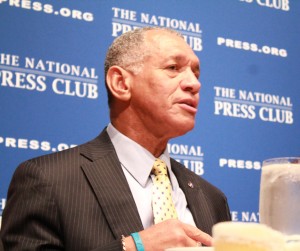
NASA Administrator Charles Bolden laid out a post-Space Shuttle plan, saying, “I'm not about to let human spaceflight go away on my watch.”
WASHINGTON — Charles Bolden sounds bullish on the future of the space program.
The NASA Administrator, who spoke Friday at the National Press Club, talked about
the agency’s plans with enthusiasm — and a laser focus on NASA’s marching orders
under President Barack Obama, who has made it clear he’s interested in radically new
space technologies.
The final launch of the Space Shuttle is set for July 8, which has fueled questions
about what’s next for NASA.
“When I hear people say – or listen to the media reports – that the final Shuttle
flight marks the end of U.S. human spaceflight,” said Bolden, “I have to say…these
folks must be living on another planet.”
With the end of the Space Shuttle program, astronaut travel to and from the Space
Station will be left to the private sector, which could be ready to start crew
flights by 2015, said Bolden.
The Constellation program, the rockets and spacecraft that NASA had been working on
to replace the space shuttles, was scuttled by the White House last year.
This leaves NASA to focus on deep-space exploration.
“President Obama has given us a mission with a capital M,” said Bolden, “To focus
again on the big picture of exploration and the crucial research and development
that will be required for us to move beyond low-earth orbit.”
Bolden pointed to the White House plan to extend U.S. exploration of space beyond
the moon. Future goals include voyages to an asteroid and eventually sending a
spacecraft into Mars orbit. Later this month, the unmanned Dawn spacecraft will drop
into orbit around the largest asteroid in the solar system, paving the way for
future manned missions.
Space Shuttle Atlantis’s destination next week, the International Space Station, is
what Bolden called “the centerpiece of our human spaceflight activities for the
coming decade.“ It will serve as a launch point for astronauts to travel deeper into
space.
As a part of the plan to take U.S. crew into Mars orbit, new spacecraft will have to
be designed to make interplanetary travel safe for astronauts. NASA named Marshall
Space Flight Center to lead the design and development of the heavy-lift Space
Launch System, required to launch a vehicle from the Space Station, but hasn’t yet
announced plans for designs to be funded.
“Despite repeated requests,” said Republican Alabama Sen. Richard Shelby, “we have
not yet been briefed by NASA on their plans for the FY11 and future funds. However,
I fully expect NASA to fulfill their legal requirements to make the 130 metric ton
SLS heavy lift rocket developed at Marshall the centerpiece of their efforts.”
Bolden didn’t directly answer questions about SLS funding Friday, but said, “We’re
nearing a decision on the heavy lift rocket, the Space Launch System, or SLS, and
will announce that soon.”
There will be a review of the Space Launch System by the House Committee on Science,
Space, and Technology July 12.
